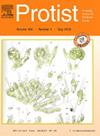Morphology and ultrastructure of marine bacterivorous bicosoecid Hirugamonas aperieos gen. et sp. nov.
IF 2.1
3区 生物学
Q4 MICROBIOLOGY
引用次数: 0
Abstract
Heterotrophic nanoflagellates (HNF) are recognized as active bacterivores in marine environments. We report the isolation and culture of a strain of HNF obtained from the seawater of Lake Hiruga. The organism has two flagella of different length, a long anterior flagellum with tripartite mastigonemes and a short smooth posterior flagellum; a spiral fiber was observed in the transition zone of the flagella. The spherical or D-shaped cell has a groove with one stretchable edge and is supported by 6–8 microtubule bundle that extends from the basal bodies and forms a cytostome. Additionally, the isolate lacked lorica, body scales, cytopharynx, or acronematic structure of flagella, and thus it could not be assigned to any known genera in the order Bicosoecida. Phylogenetic analysis of 18S rRNA gene sequences from Bicosoecida confirmed an independent clade at the genus level with the closest relative genus being Bicosoeca. The optimal salinity and temperature ranges for growth was 21 %–30 % and 25–31 °C, respectively, indicating a marine mesophilic HNF. Thus, based on the morphological features and phylogenetic analysis of 18S rRNA gene sequences, we propose a novel genus for the isolate: Hirugamonas, n. gen. The species name Hirugamonas aperieos sp. nov. is proposed.
海洋嗜菌生物鱿鱼的形态和超微结构。
异养纳米鞭毛虫(HNF)被认为是海洋环境中活跃的细菌捕食者。我们报道了从平贺湖海水中分离和培养的一株HNF。该生物有两个不同长度的鞭毛,前鞭毛长且有三节鞭毛,后鞭毛短而光滑;鞭毛过渡区有螺旋状纤维。球形或d形细胞具有具有一个可拉伸边缘的凹槽,并由6-8微管束支撑,该微管束从基底延伸并形成细胞壁。此外,该分离物缺乏鞭毛、体鳞、细胞咽或鞭毛的首字母缩略结构,因此它不能被分配到任何已知的生物虫目属。对其18S rRNA基因序列进行系统发育分析,证实其属水平上为独立支系,最近的亲缘属为Bicosoeca。生长的最佳盐度和温度范围分别为21% ~ 30%和25 ~ 31℃,为海洋中温型HNF。因此,基于18S rRNA基因序列的形态特征和系统发育分析,我们提出了该分离物的新属:Hirugamonas, n. gen.,种名为Hirugamonas aperieos sp. nov。
本文章由计算机程序翻译,如有差异,请以英文原文为准。
求助全文
约1分钟内获得全文
求助全文
来源期刊

Protist
生物-微生物学
CiteScore
3.60
自引率
4.00%
发文量
43
审稿时长
18.7 weeks
期刊介绍:
Protist is the international forum for reporting substantial and novel findings in any area of research on protists. The criteria for acceptance of manuscripts are scientific excellence, significance, and interest for a broad readership. Suitable subject areas include: molecular, cell and developmental biology, biochemistry, systematics and phylogeny, and ecology of protists. Both autotrophic and heterotrophic protists as well as parasites are covered. The journal publishes original papers, short historical perspectives and includes a news and views section.
 求助内容:
求助内容: 应助结果提醒方式:
应助结果提醒方式:


